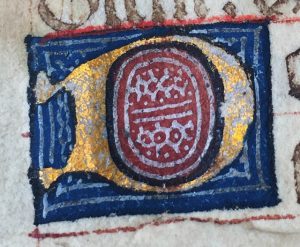
Medieval manuscripts are a “niche interest” in the academic world. Even within the realms of English, history, and art, these beautiful, hand-written documents largely go unexplored.
One possible reason for this is that academics—students, teachers, researchers, etc.—simply don’t know how accessible these materials are. Here at the University of Georgia, we have a small but broad collection of medieval manuscripts. Yet, when I talk about this class and the kinds of materials we work with, other students can’t even comprehend that we have access to these historic materials. When I try to describe what it is like to work with them, I am never able to do the their beauty justice. No matter what, I struggle in making this area sound interesting because if you’re not a part of this “niche interest group,” you really don’t see the appeal.
I always tell people, “These documents are breathtaking,” and they nod their heads and say, “I’m sure.” But I can tell they really want to ask me, “how can something so old be so beautiful?”
The thing is, these documents don’t necessarily conform to today’s beauty standards. Each manuscript is unique, and it’s in that uniqueness that their beauty lies. What makes these manuscripts so enticing is how they were made—what pigments were used where, what scripts were used, what glosses were included (or not included), what damage there is and when or how it occurred. All of these factors go into making a manuscript what it is, in defining its own singular character. These fragments and codices are made up of the same backbones—usually parchment, ink, and pigments for illuminations, and yet, they are each their own. And it’s from this sense of individuality that the beauty of these manuscripts arises. Seeing the insect damage of a manuscript up close and personal, discovering that the damage actually is insect damage. That process makes working with these materials so exciting.
The fragment that I have been working with throughout this semester seems somewhat plain at first glance. There are no fancy illuminations or extravagant decorated initials. Instead, our fragment has suffered large amounts of damage, including what my partner and I call three claw marks, each about three inches long. Its few decorated champ initials have degraded, the gold leafing is low-quality, and the script is so faded it is almost unreadable. My partner and I fought with this difficult fragment day in and day out, but by the end, we came away with a deep feeling of satisfaction. We correctly identified the fragment as being a part of the Mass of the Catechumens, and to our best efforts, we transcribed bits of the text. Every bit of damage to the manuscript puzzled us. To this day, we are not sure what caused the “claw marks.” All we know is that the cuts are clean, so they are not a result of insect damage. Was the page torn somehow? Possibly. Did someone take a three-pronged knife to it in a rage? Maybe. Could the werewolf who owned this manuscript have slashed at the page during a transformation? Who knows. All we know is that these marks are there, and the potential stories behind how they got there are what creates the story behind the manuscript itself.

In order for others to learn the stories behind these manuscripts, we must make these materials more accessible. One way to do that is to make them more visible online. Many other universities have the same issue as we do of showcasing these materials to their full potential. During our web design proposal project, in which we designed a landing page for the Hargrett website, my group and I found that aesthetically pleasing websites were usually easier to navigate. We also found that those websites also gave more concrete information about their medieval collections. Some universities have even digitized their collections to allow anyone to see their fragments from anywhere. Having a digitized collection would help spark the interest in medieval manuscripts. Once interest is sparked, students and researchers would want to see more. They’d want to handle them in person.
Working with the librarians as closely as we have, I’ve learned how much they care about these materials, and how much they want students and researchers and teachers to make use of them. And after studying a fragment in depth, I want them to be visible and used as much as the librarians do. If other students could just see, could just glimpse into the realm of medieval manuscripts, maybe this area of interest wouldn’t be so “niche” anymore.
-Lauren Amidon